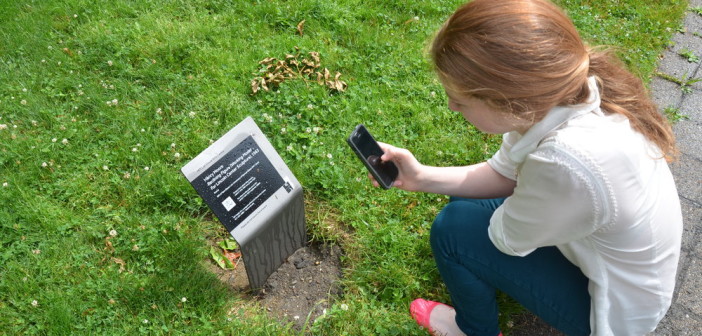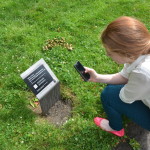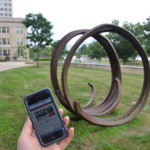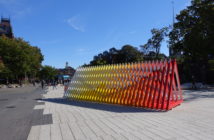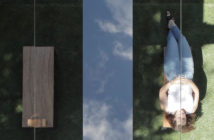The MIT List Visual Arts Center recently launched an audio guide for its public art collection that focuses on 51 notable works and offers varied insights into the collection. When visiting the mostly outdoor collection in person, each of these 51 works has a sign indicating a phone number to call to access the guide as well as QR codes that can be scanned.
Art and MIT is not such a strange combination. In fact, MIT has developed innovative art programs and is continually expanding their collection. Their Percent-for-Art Program allots up to $250,000 to commission art for each new building or renovation project. Developed in 1968, this program was the first of its kind at a private institution of higher education. The school’s dedication to supporting new public art stands in contrast to the city of Boston, which has no comparable program.
The List Visual Arts Center, which developed the new audio guide, administers all art programs at MIT including the public art collection. In art circles, the List is world renowned, yet each time I go to a List event, I am surprised by the poor attendance. Former List director Patricia Fuller noted in a MIT News article that the most common response to her public art tours was "I had no idea that all this was at MIT." The visibility of art at MIT needs to be widened, and the addition of this audio guide is a significant step in broadening their public audience.
With the audio guide also available online, this new resource is publicizing the collection to the world. The audio guide introduction is narrated by Leonard Nimoy, of Star Trek fame, highlighting MIT’s desire to generate popular interest in their art programs. To make visiting the works convenient, an interactive map shows where each work is situated on campus. Many of the public art works are off limits to the public, located in residences or offices, but MIT offers private tours of each of these works, and a phone number is included in each audio guide to make the work available to those who are interested. Incredible effort is being made to turn this art situated on a private university into a public attraction. The collection is world-class and should attract the attention it deserves.
The audio guide is easy to use and highlight the best-known pieces in the collection including works by Alexander Calder, Mark di Suvero, Dan Graham, Jaume Plensa, Sarah Sze, and Lawrence Weiner. Around two minutes long, each clip explores how a work was created, its conceptual background, and its position within the artist’s oeuvre. The guide also includes delightful segments of artists speaking on their own works. A highlight is Sarah Sze’s discussion of her work Blue Poles commissioned for the Sidney-Pacific Graduate Residence. Her ladder-like structures are attached to the side of the residence and reference her childhood growing up in Boston. Made to be a miniature fire escape (perhaps for a cat, she notes), Sze discusses how fire escapes are now located in the interior of new buildings, like the residence, and she feels that fire escape give the modern landscape a human element.
Another way the audio guide illuminates the works is to highlight their connection to the MIT community. Alexander Calder’s monolithic, modern La Grande Voile may appear as an anonymous work with no connection to its site, but buried underneath this work is a time capsule with items selected by MIT professors. Included in the capsule are a Betty Crocker cookbook, a copy of the MIT student newspaper The Tech, and an annual report of the Eastern Standard Oil Company. Artist Jim Melchert worked with MIT professors when they requested he incorporate images of microorganism into his work Coming to Light, connecting the work to research being done in the building. These insights offer visitors a new way to look at the works. More generally, the audio guide offers new access into one of America’s great public art collections.
Thumbnail Photo: Bernar Venet (France, 1941 - ), Two Indeterminate Lines, 1993
Rolled steel, 87 in. x 87 in. x 98.5 in. (220.98 cm x 220.98 cm x 250.19 cm), Gift of Elliot K. Wolk, MIT Class of 1957. Location: Sloan School of Management, River Court lawn (bldg. E62) Photo: MIT List Visual Art Center
- Photo courtesy MIT List Visual Arts Center
- Photo courtesy MIT List Visual Arts Center (pictured in the background: Bernar Venet, Two Indeterminate Lines, 1993

